Direct Ink Writing of Three-Dimensional (K, Na)NbO3-Based Piezoelectric Ceramics
Abstract
:1. Introduction
2. Experimental Section
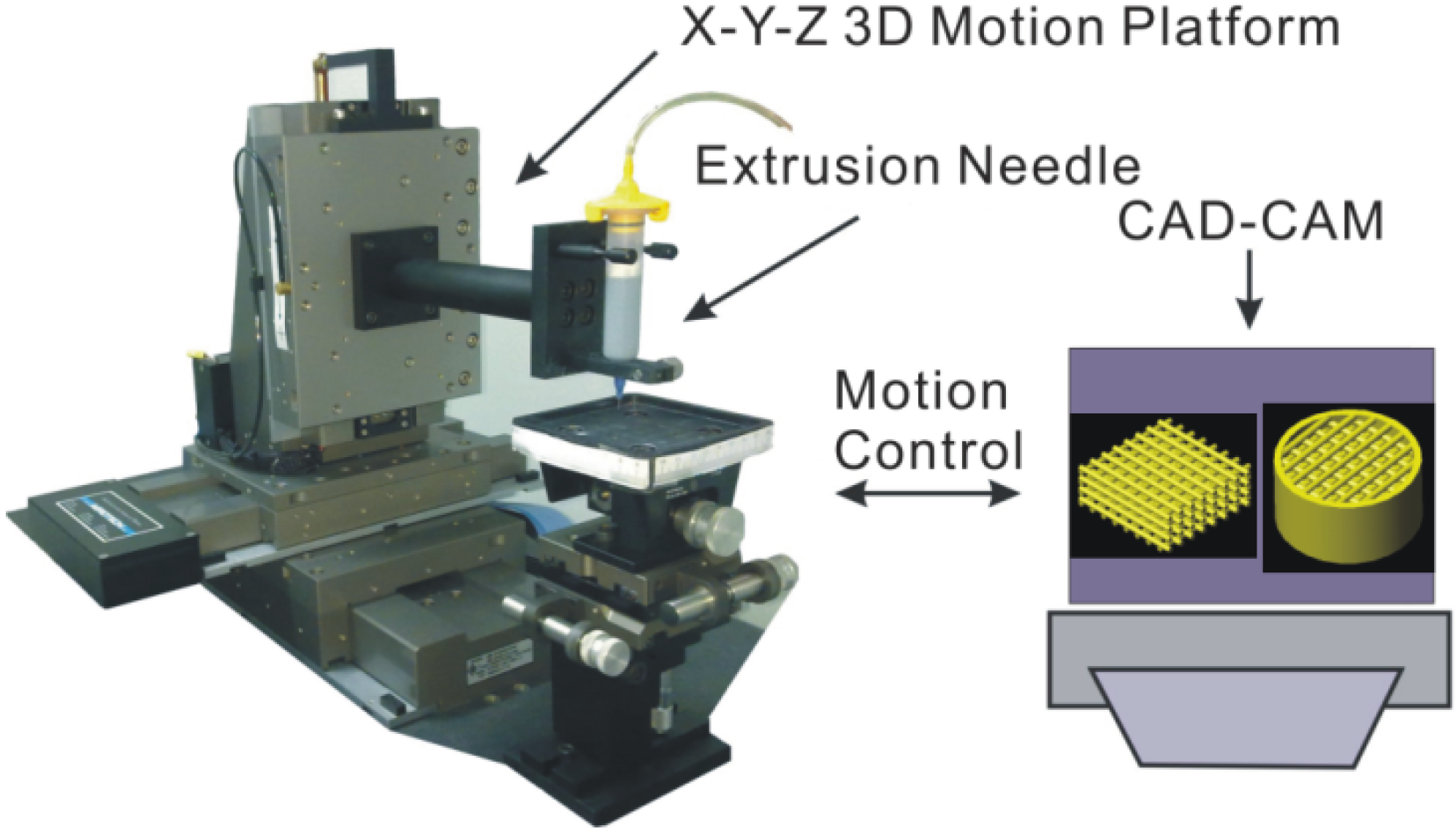
3. Results and Discussion
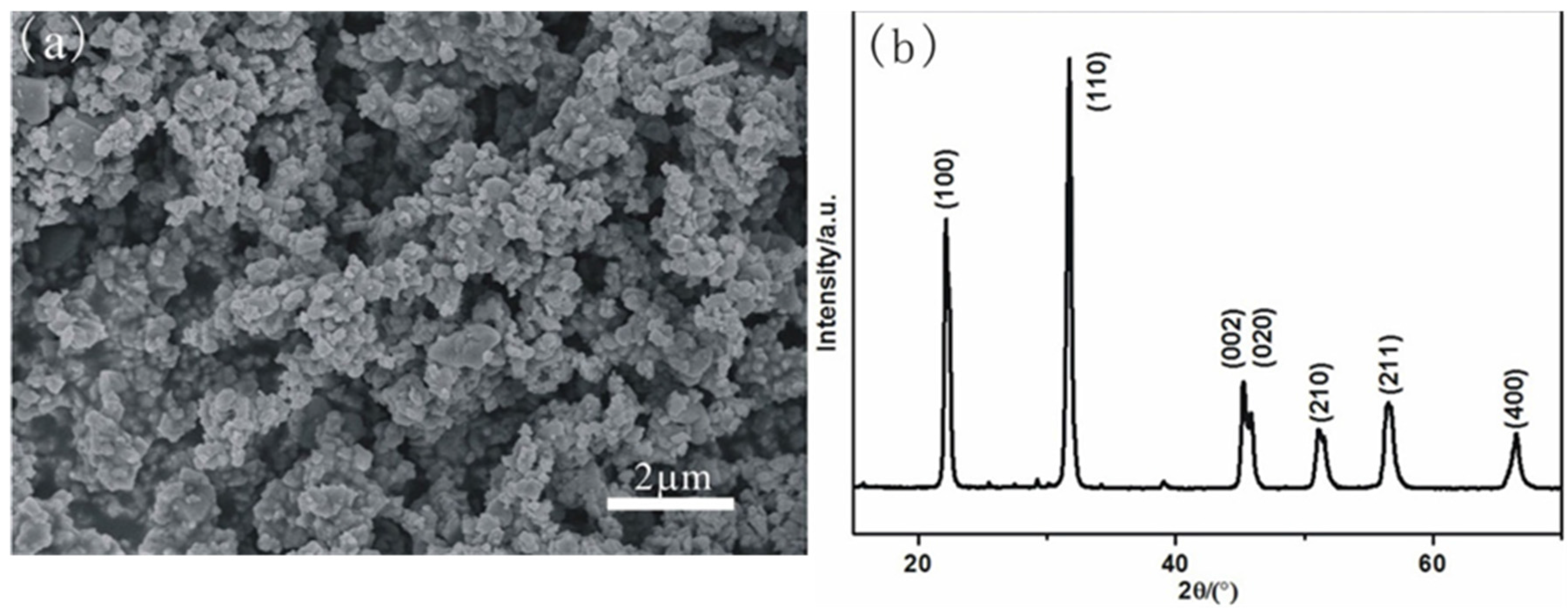
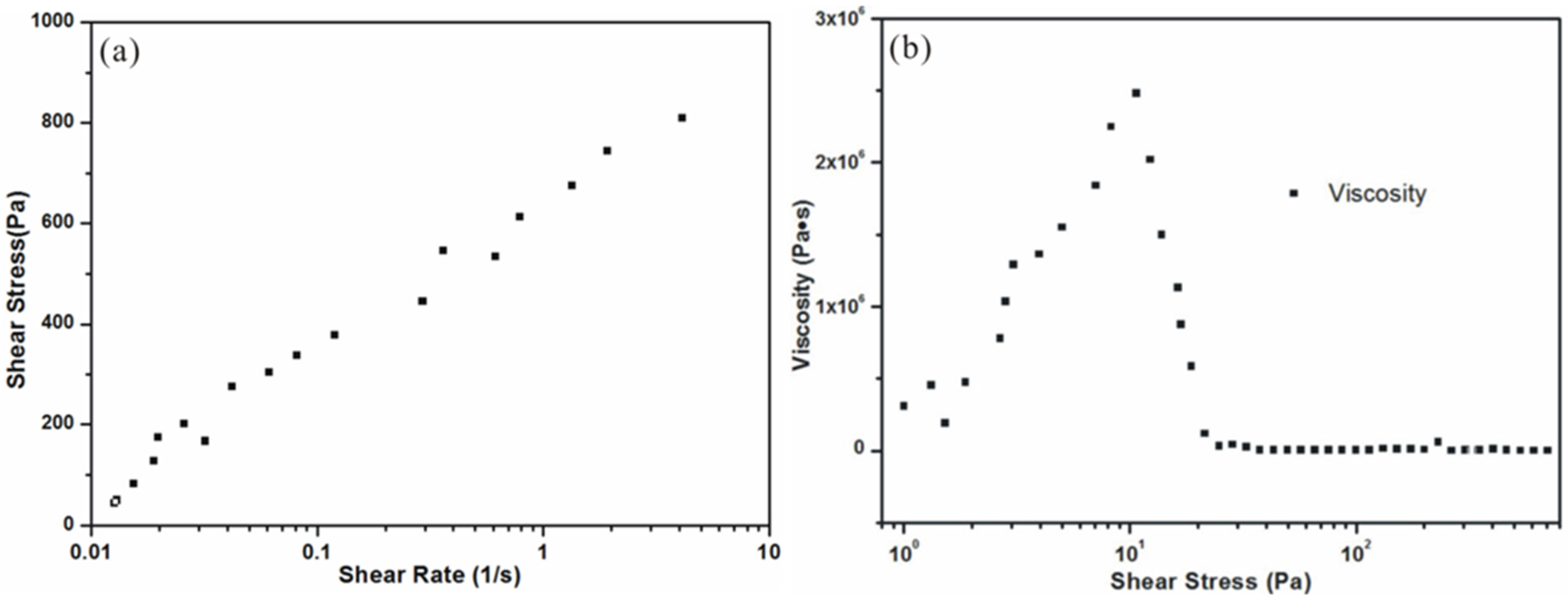
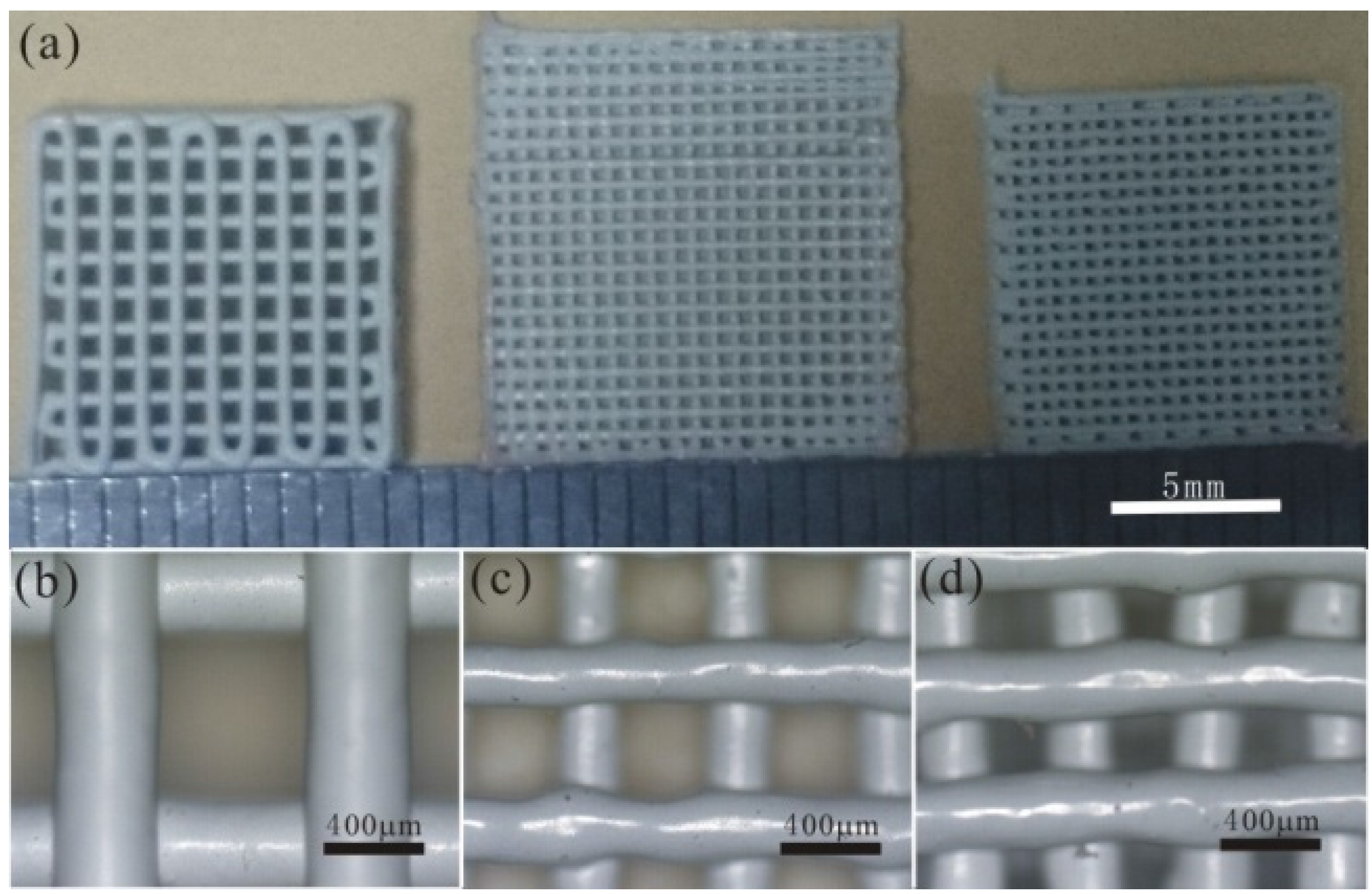

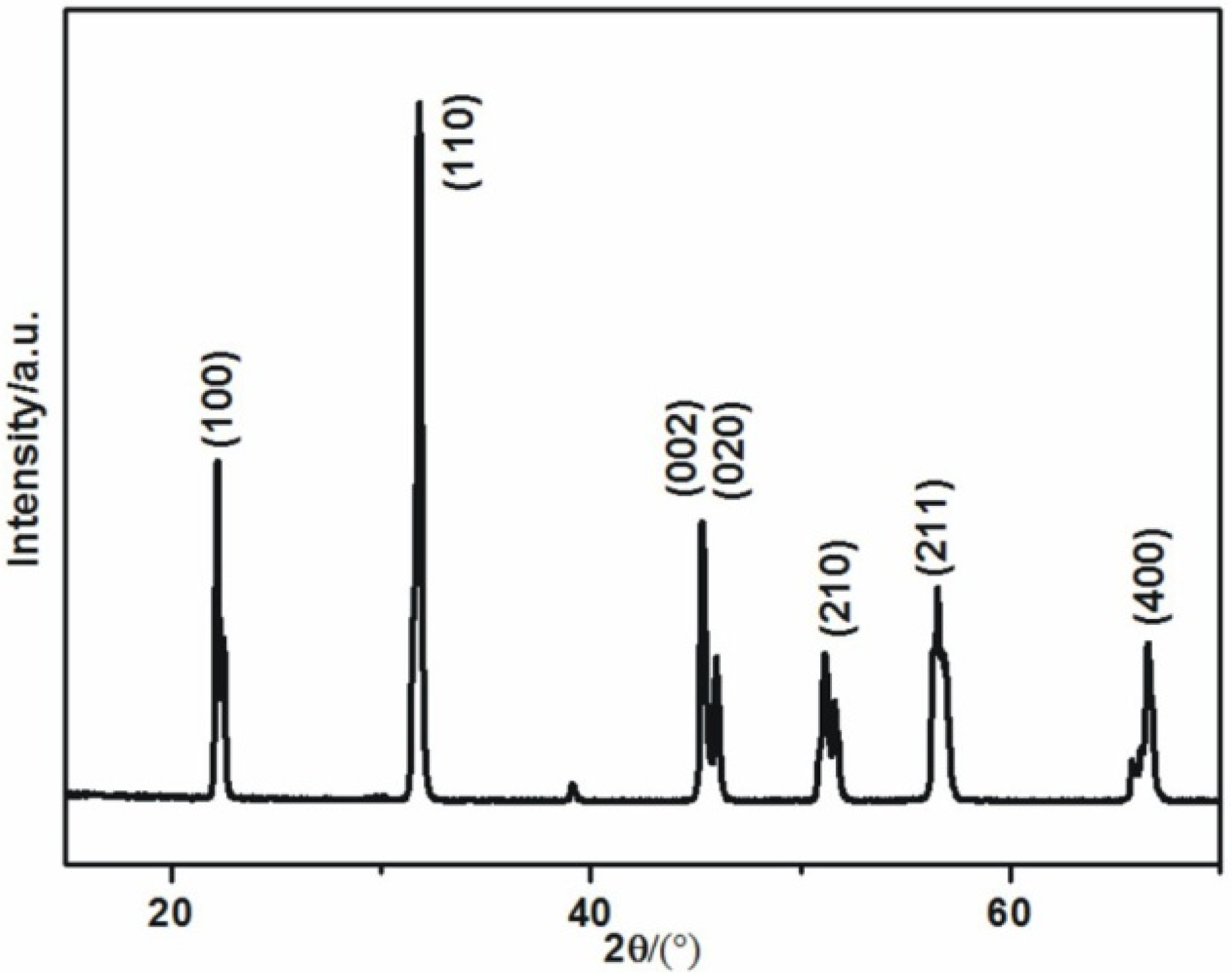
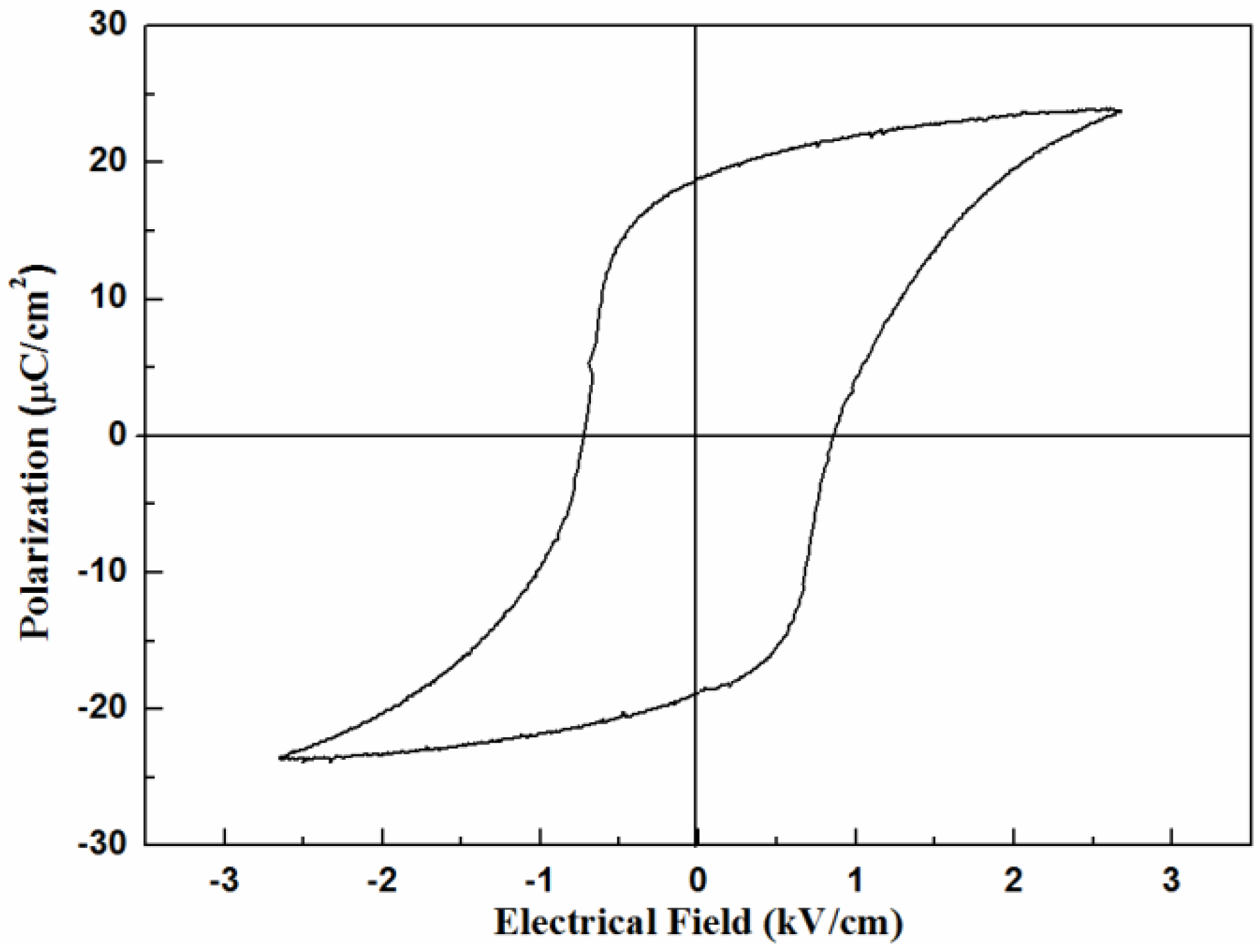
| Electrical properties | ε33/ε0 | d33 (pC/N) | Pr (μC/cm2) | Ec (kV/cm) |
|---|---|---|---|---|
| KNN sample | 1775 | 280 | 18.8 | 8.5 |
4. Conclusions
Acknowledgments
Author Contributions
Conflicts of Interest
References
- Saito, Y.; Takao, H.; Tani, T.; Nonoyama, T.; Takatori, K.; Homma, T.; Nagaya, T.; Nakamura, M. Lead-free piezoceramics. Nature 2004, 432, 84–87. [Google Scholar] [CrossRef] [PubMed]
- Ha, J.; Ryu, J.; Lee, H. Substitution behavior of x(Na0.5K0.5)NbO3-(1−x)BaTiO3 ceramics for multilayer ceramic capacitors by a near edge X-ray absorption fine structure analysis. Appl. Phys. Lett. 2014, 104, 262904:1–262904:4. [Google Scholar]
- Lu, L.; Gong, Y.Q.; Gong, L.J.; Dong, H.D.; Dong, H.; Yi, X.F.; Zheng, X.J. Low-temperature hydro/solvothermal synthesis of Ta-modified K0.5Na0.5NbO3 powders and piezoelectric properties of corresponding ceramics. Mater. Des. 2012, 33, 362–366. [Google Scholar]
- Toshio, K.; Yuan, Y.; Fumito, S. Mechanisms of texture development in lead-free piezoelectric ceramics with perovskite structure made by the templated grain growth process. Materials 2010, 3, 4965–4978. [Google Scholar] [CrossRef]
- Dai, Y.J.; Zhang, X.W.; Zhou, G.Y. Phase transitional behavior in K0.5Na0.5NbO3-LiTaO3 ceramics. Appl. Phys. Lett. 2007, 90, 262903:1–262903:3. [Google Scholar]
- Zuo, R.Z.; Fu, J.; Lv, D.Y.; Liu, Y. Antimony tuned rhombohedral-orthorhombic phase transition and enhanced piezoelectric properties in sodium potassium niobate. J. Am. Ceram. Soc. 2010, 93, 2783–2787. [Google Scholar] [CrossRef]
- Fisher, J.G.; Rout, D.; Moon, S.K.; Kang, S.J.L. Structural changes in potassium sodium niobate ceramics sintered in different atmospheres. J. Alloys Compd. 2009, 479, 467–472. [Google Scholar] [CrossRef]
- Fu, J.; Zuo, R.Z.; Wang, X.H.; Li, L.T. Phase transition characteristics and piezoelectric properties of compositionally optimized alkaline niobate based ceramics. J. Alloys Compd. 2009, 486, 790–794. [Google Scholar] [CrossRef]
- Wang, X.P.; Wu, J.G.; Xiao, D.Q.; Zhu, J.G.; Cheng, X.J.; Zheng, T.; Zhang, B.Y.; Lou, X.J.; Wang, X.J. Giant piezoelectricity in potassium-sodium niobate lead-free ceramics. J. Am. Ceram. Soc. 2014, 136, 2905–2910. [Google Scholar]
- Lee, Y.; Yoo, J.; Lee, K.; Kim, I.; Song, J.; Park, Y.W. Dielectric and piezoelectric characteristics of the non-stoichiometric (Na, K)NbO3 ceramics doped with CuO. J. Alloys Compd. 2010, 506, 872–876. [Google Scholar] [CrossRef]
- Wang, Y.L.; Damjanovic, D.; Klein, N.; Setter, N. High-temperature instability of Li- and Ta- modified (K, Na)NbO3 piezoceramics. J. Am. Ceram. Soc. 2008, 91, 1962–1970. [Google Scholar] [CrossRef]
- Ming, B.Q.; Wang, J.F.; Qi, P.; Zang, G.Z. Piezoelectric properties of (Li, Sb, Ta) modified (Na, K)NbO3 lead-free ceramics. J. Appl. Phys. 2007, 101, 054103:1–054103:4. [Google Scholar] [CrossRef]
- Kwok, K.W.; Hon, S.F.; Lin, D. Lead-free self-focused piezoelectric transducers for viscous liquid ejection. Sens. Actuators A Phys. 2011, 168, 168–171. [Google Scholar] [CrossRef]
- Wu, D.W.; Chen, R.M.; Zhou, Q.F.; Shung, K.K.; Lin, D.M.; Chan, H.L.W. Lead-free KNLNT piezoelectric ceramics for high-frequency ultrasonic transducer application. Ultrasonic 2009, 49, 395–398. [Google Scholar] [CrossRef]
- Hong, J.; Yoo, J.; Lee, K.; Lee, S.; Song, H. Characteristics of acoustic emission sensor using lead-free (LiNaK)(NaTaSb)O3 ceramics for fluid leak detection at power plant valves. Jpn. J. Appl. Phys. 2008, 47, 2192–2194. [Google Scholar] [CrossRef]
- Oh, Y.; Noh, J.; Yoo, J.; Kang, J.; Hwang, L.; Hong, J. Dielectric and piezoelectric properties of CeO2-added Nonstoichiometric (Na0.5K0.5)0.97(Nb0.96Sb0.04)O3 ceramics for piezoelectric energy harvesting device applications. IEEE Trans. Ultrason. Ferroelectr. Freq. Control 2011, 58, 1860–1866. [Google Scholar]
- Lee, T.; Kwok, K.W.; Li, H.L.; Chan, H.L.W. Lead-free alkaline niobate-based transducer for ultrasonic wirebonding applications. Sens. Actuators A Phys. 2009, 150, 267–271. [Google Scholar] [CrossRef]
- Shen, Z.Y.; Li, J.F.; Chen, R.M.; Zhou, Q.F.; Shung, K.K. Microscale 1–3 type (Na, K)NbO3-based Pb-free piezocomposites for high-frequency ultrasonic transducer applications. J. Am. Ceram. Soc. 2011, 94, 1346–1349. [Google Scholar] [CrossRef] [PubMed]
- Zhou, D.; Lam, K.H.; Chen, Y.; Zhang, Q.H.; Chiu, Y.C.; Luo, H.; Dai, J.Y.; Chan, H.L.W. Lead-free piezoelectric single crystal based 1–3 composites for ultrasonic transducer applications. Sens. Actuators A Phys. 2012, 182, 95–100. [Google Scholar] [CrossRef]
- Xu, Y.; Li, J.F.; Ma, J.; Nan, C.W. Magnetoelectricity of lateral 1–3 type composites with CoFe2O4 ferromagnetic microstrips embedded in (K, Na)NbO3-based piezoelectric substrate. J. Appl. Phys. 2011, 110, 044104:1–044104:4. [Google Scholar]
- Li, L.H.; Deng, J.X.; Chen, J.; Yu, R.B.; Qiao, L.J.; Xing, X.R. Piezoelectric and ferroelectric properties of 0.96(Na,K)(Nb0.9Ta0.1)O3–0.04LiSbO3 ceramics synthesized by molten salt method. J. Alloys Compd. 2009, 471, 428–431. [Google Scholar]
- Urban, J.J.; Spanier, J.E.; Lian, O.Y.; Yun, W.S.; Park, H. Single-crystalline barium titanate nanowires. Adv. Mater. 2003, 15, 423–426. [Google Scholar] [CrossRef]
- Farooq, M.U.; Fisher, J.G. Growth of (K0.5Na0.5)NbO3SrTiO3 lead-free piezoelectric single crystals by the solid state crystal growth method and their characterization. Ceram. Int. 2014, 40, 3199–3207. [Google Scholar]
- Hou, Y.D.; Hou, L.; Zhang, T.T.; Zhu, N.K.; Wang, H.; Yan, H. (Na0.8K0.2)0.5Bi0.5TiO3 nanowires: Low-temperature sol-gel-hydrothermal synthesis and densification. J. Am. Ceram. Soc. 2007, 90, 1738–1743. [Google Scholar]
- Lewis, J.A. Direct-write assembly of ceramics of colloidal inks. Curr. Opin. Solid State Mater. Sci. 2002, 6, 245–250. [Google Scholar] [CrossRef]
- Li, J.F.; Wang, K.; Zhu, F.Y.; Cheng, L.Q.; Yao, F.Z. (K, Na)NbO3-based lead-free piezoceramics: Fundamental aspects, processing technologies, and remaining challenges. J. Am. Ceram. Soc. 2013, 96, 3677–3696. [Google Scholar] [CrossRef]
- Li, Y.Y.; Li, B.; Li, L.T. Fabrication of 3D photocatalytic α-Fe2O3 structure using direct ink writing method. Mod. Phys. Lett. B 2014, 28, 1450051. [Google Scholar] [CrossRef]
- Simon, J.L.; Michna, S.; Lewis, J.A.; Rekow, E.D.; Thompson, V.P.; Smay, J.E.; Yampolsky, A.; Parsons, J.R.; Ricci, J.L. In vivo bone response to 3D periodic hydroxyapatite scaffolds assembled by direct ink writing. J. Biomed. Mater. Res. A 2006, 83A, 747–758. [Google Scholar]
- San, C.M.; Kouzeli, M.; Rao, R.; Lewis, J.A.; Dunand, D.C. Alumina-aluminum interpenetrating-phase composites with three-dimensional periodic architecture. Scr. Mater. 2013, 49, 861–866. [Google Scholar]
- Cai, K.P.; Li, Y.Y.; Sun, Z.X.; Sun, J.B.; Li, B.; Zhou, J. Preparation of 3D ceramic meshes by direct-write method and modulation of its photocatalytic properties by structure design. J. Inorg. Mater. 2012, 27, 102–106. [Google Scholar] [CrossRef]
- Li, Y.Y.; Li, B.; Sun, J.B.; Cai, K.P.; Zhou, J.; Li, L.T. Direct write assembly of 3-dimensional structures with aqueous-based piezoelectric inks. Key Eng. Mater. 2012, 512, 390–394. [Google Scholar] [CrossRef]
© 2015 by the authors; licensee MDPI, Basel, Switzerland. This article is an open access article distributed under the terms and conditions of the Creative Commons Attribution license (http://creativecommons.org/licenses/by/4.0/).
Share and Cite
Li, Y.; Li, L.; Li, B. Direct Ink Writing of Three-Dimensional (K, Na)NbO3-Based Piezoelectric Ceramics. Materials 2015, 8, 1729-1737. https://doi.org/10.3390/ma8041729
Li Y, Li L, Li B. Direct Ink Writing of Three-Dimensional (K, Na)NbO3-Based Piezoelectric Ceramics. Materials. 2015; 8(4):1729-1737. https://doi.org/10.3390/ma8041729
Chicago/Turabian StyleLi, Yayun, Longtu Li, and Bo Li. 2015. "Direct Ink Writing of Three-Dimensional (K, Na)NbO3-Based Piezoelectric Ceramics" Materials 8, no. 4: 1729-1737. https://doi.org/10.3390/ma8041729





